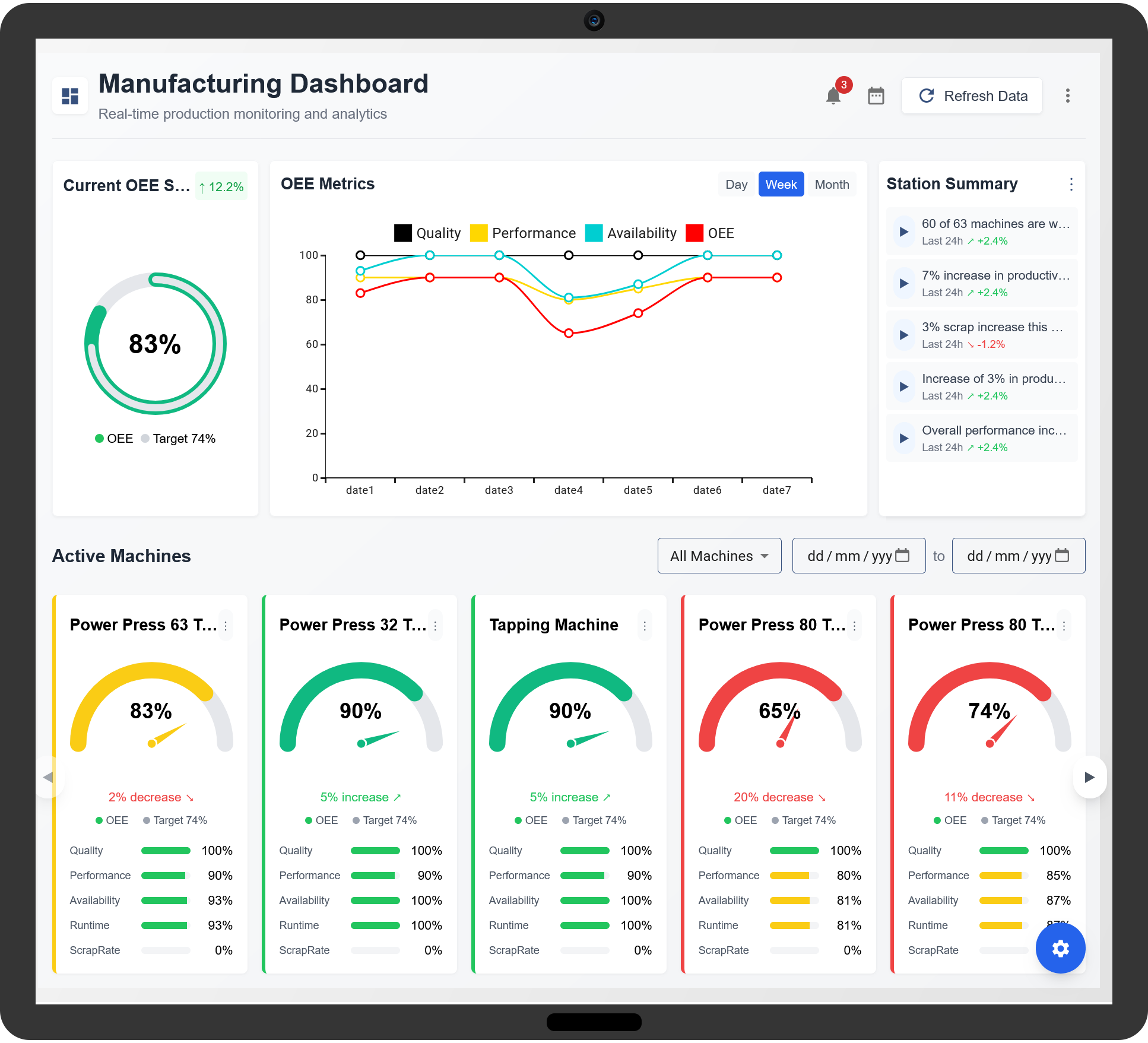Overall Equipment Effectiveness (OEE) is a key performance metric used in manufacturing to evaluate the efficiency and effectiveness of production equipment. It measures three critical factors—Availability, Performance, and Quality—to determine the overall efficiency of a manufacturing process. By understanding and improving OEE, manufacturers can enhance productivity, reduce waste, and optimize production operations.

1. Understanding the Components of OEE
- Availability: Measures the proportion of scheduled production time in which equipment is running. It accounts for planned and unplanned downtime, such as maintenance, breakdowns, or changeovers.
- Performance: Evaluates how efficiently the equipment operates when running. It considers factors such as speed losses and minor stoppages that reduce overall productivity.
- Quality: Assesses the proportion of manufactured products that meet quality standards. It accounts for defects, rework, and scrap.
OEE is calculated using the formula:
OEE = Availability × Performance × Quality
The result is expressed as a percentage, with 100% indicating perfect production—meaning no downtime, optimal speed, and zero defects.
2. How OEE Works in Manufacturing
OEE provides manufacturers with a clear picture of their production efficiency. By tracking and analyzing OEE data, companies can identify inefficiencies, reduce downtime, and optimize equipment performance. Key ways OEE is applied in manufacturing include:
- Identifying Bottlenecks: OEE data helps pinpoint areas causing slowdowns in production.
- Reducing Downtime: By tracking equipment failures, manufacturers can implement preventive maintenance strategies.
- Improving Quality Control: Monitoring defects and rework rates ensures a higher standard of production.
- Enhancing Productivity: Data-driven decision-making helps streamline manufacturing processes.
3. How to Measure and Improve OEE in Manufacturing
Step 1: Collect Production Data
Gather real-time data on machine availability, performance speed, and defect rates. Use sensors, manual logs, or OEE software to record information accurately.
Step 2: Calculate OEE Metrics
Use the OEE formula to determine Availability, Performance, and Quality percentages. Multiply these values to obtain the overall OEE score.
Step 3: Analyze Inefficiencies
Identify the root causes of low OEE scores by examining downtime reasons, production speed losses, and quality issues.
Step 4: Implement Improvements
Develop strategies to address inefficiencies, such as scheduling preventive maintenance, optimizing machine settings, and training employees on best practices.
Step 5: Monitor and Optimize
Continuously track OEE data, adjust improvement strategies, and refine processes to enhance overall manufacturing efficiency.
4. Benefits of Using OEE in Manufacturing
- Increased Productivity: Helps optimize machine utilization and minimize waste.
- Reduced Downtime: Prevents unexpected equipment failures through predictive maintenance.
- Higher Product Quality: Ensures fewer defects and rework, reducing material costs.
- Cost Efficiency: Enhances operational efficiency and reduces overall manufacturing expenses.
- Data-Driven Decision-Making: Provides real-time insights to improve production planning.
5. The Future of OEE in Manufacturing
As technology evolves, OEE will continue to play a crucial role in manufacturing. Advancements such as automation, IoT-enabled monitoring, and AI-driven predictive analytics will further enhance the accuracy and usability of OEE data. Companies that invest in improving their OEE strategies will gain a competitive edge by maximizing production efficiency and maintaining high-quality standards.
By implementing OEE measurement and improvement strategies, manufacturers can drive continuous operational excellence and achieve long-term success in the industry.
What is OEE and how does it work in Manufacturing
What is OEE?
OEE (Overall Equipment Effectiveness) is a metric used in manufacturing to measure the efficiency and effectiveness of equipment by evaluating availability, performance, and quality.
Why is OEE important in manufacturing?
OEE helps manufacturers identify inefficiencies, reduce downtime, and optimize production processes to improve productivity.
What are the key components of OEE?
OEE consists of three factors: Availability (machine uptime), Performance (speed efficiency), and Quality (defect-free production).
How is OEE calculated?
OEE is calculated using the formula: OEE = Availability × Performance × Quality, expressed as a percentage.
What is considered a good OEE score?
An OEE score of 85% or higher is considered world-class, while 60-85% indicates room for improvement.
How does OEE help reduce production losses?
By analyzing OEE components, manufacturers can identify and address production losses caused by downtime, speed reductions, and defects.
What factors affect OEE in manufacturing?
Factors include equipment failures, unplanned downtime, slow cycle times, setup delays, and production defects.
How can manufacturers improve their OEE?
Manufacturers can improve OEE by reducing downtime, optimizing machine speed, minimizing defects, and implementing predictive maintenance.
What is the role of OEE in lean manufacturing?
OEE supports lean manufacturing by eliminating waste, improving efficiency, and maximizing production output.
How does OEE support predictive maintenance?
OEE data helps predict equipment failures by identifying performance trends, allowing proactive maintenance scheduling.
Can OEE be applied to different types of manufacturing industries?
Yes, OEE is a universal metric applicable to industries such as automotive, food production, electronics, and pharmaceuticals.
What is the difference between OEE and productivity?
OEE measures equipment effectiveness, while productivity considers overall output, including labor and material efficiency.
How does automation impact OEE?
Automation improves OEE by reducing human error, increasing consistency, and optimizing machine efficiency.
What tools can be used to track OEE?
OEE can be tracked using manufacturing execution systems (MES), IoT-enabled sensors, and digital dashboards.
How often should manufacturers measure OEE?
OEE should be measured continuously in real-time or analyzed daily, weekly, and monthly for trend analysis.